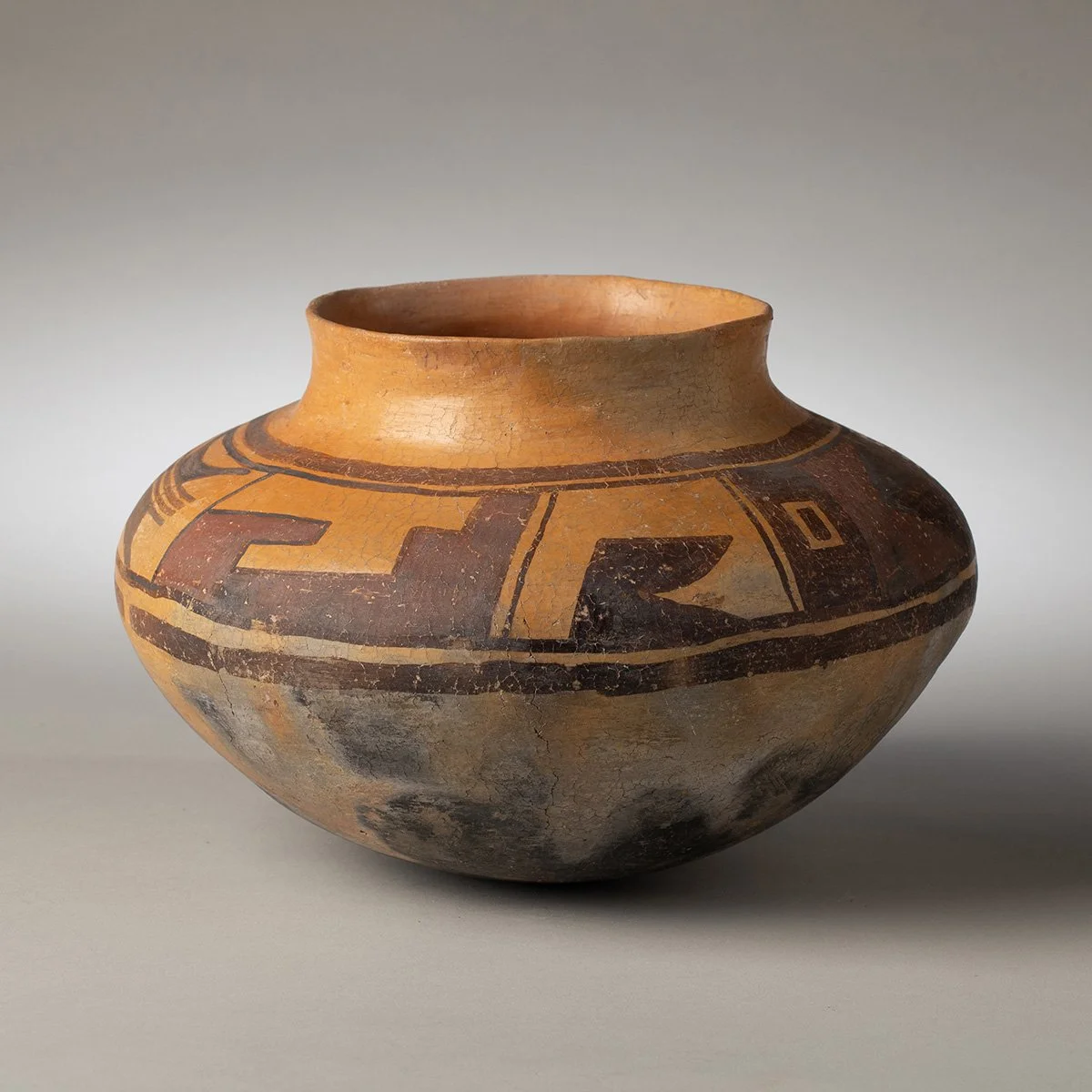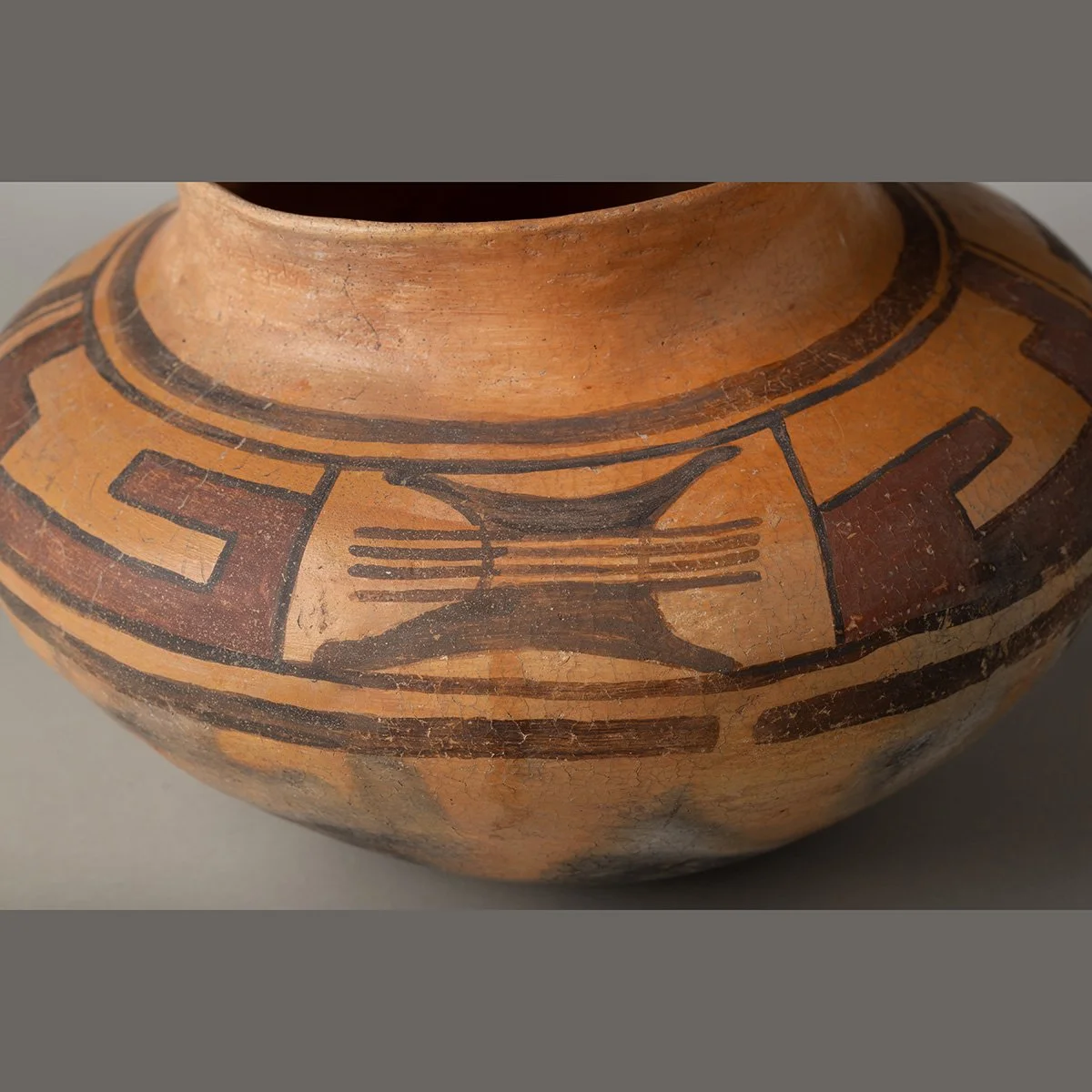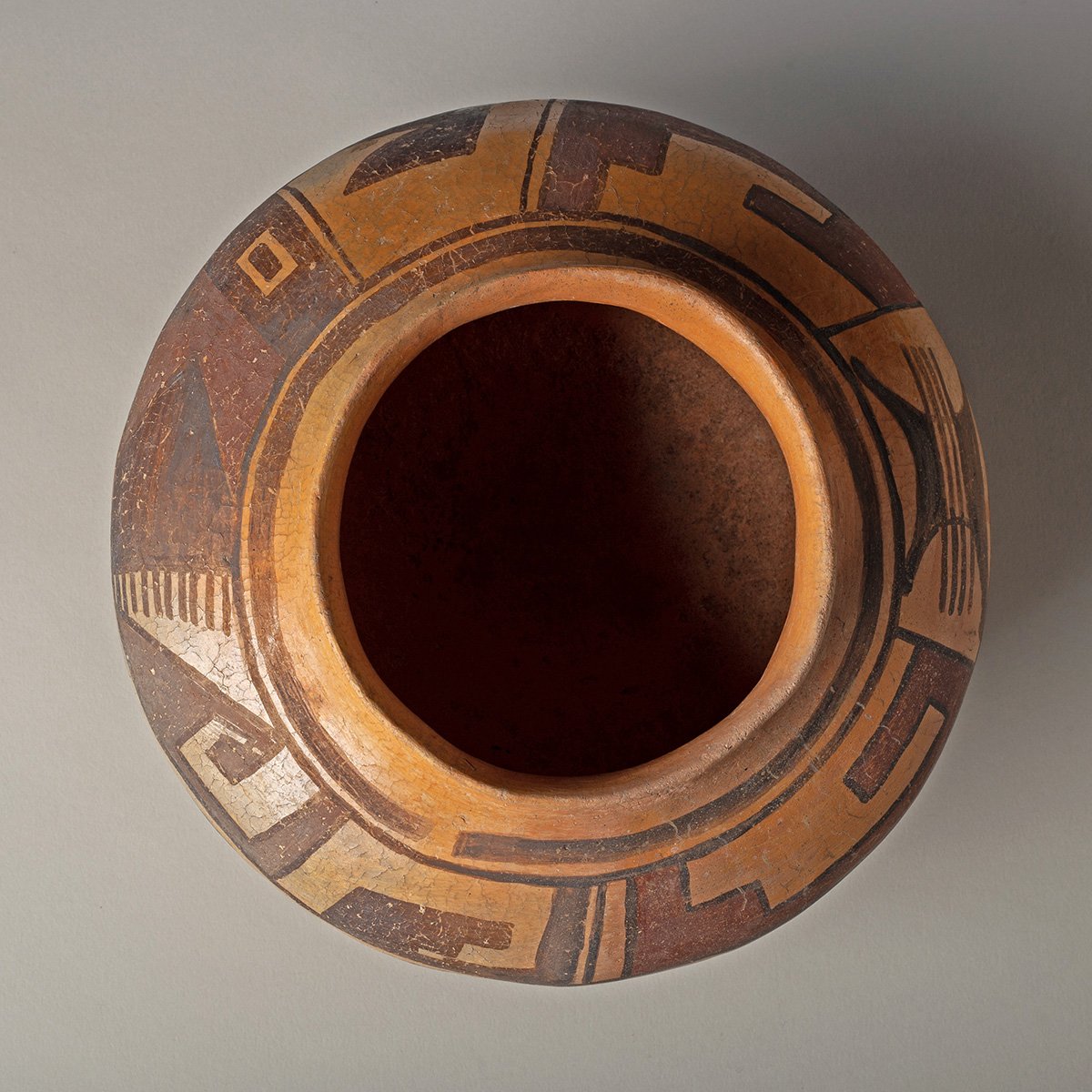 Image 1 of 7
Image 1 of 7

 Image 2 of 7
Image 2 of 7

 Image 3 of 7
Image 3 of 7

 Image 4 of 7
Image 4 of 7

 Image 5 of 7
Image 5 of 7

 Image 6 of 7
Image 6 of 7

 Image 7 of 7
Image 7 of 7








Fine Matsaki Polychrome Olla
New Mexico
1350 - 1450 AD
Height 7” Diameter 10"
Provenance: Billy Schenck, Santa Fe, NM
Matsaki Polychrome was defined by Reed (1955). This type reflects changes that occurred during the initial replacement of glaze by matte mineral paint in the Zuni area. Matsaki Red on Buff and Polychrome are distinguished based solely on observation relating to designs in one (a reddish or brownish paint) versus two (reddish and black pigments. These types reflect the appearance of new styles executed in red and black matte paint (Dittert and Plog 1989). Matasaki Polychrome is common in assemblages dating from the beginning of the fifteenth to the early seventeenth century (Mills 2007).
Surfaces are lightly polished with a rough or crazed surface and covered with a buff, yellow, brown to orange slip. Pastes are light tan, gray, to orange. Temper consists of small angular particles with occasional sand. Forms are dominated by bowls with varying profiles but also include various jar forms. Painted styles commonly consist of asymmetrical designs similar to those noted in Sikyatki Polychrome produced in the Hopi region although the overall quality of execution tends to be poorer. For bowls, there is shift to painted decorations in interior only, and exterior surfaces are either plain slipped buff or have one or two stripes in the upper area. Surfaces are sometimes decorated in a band of panels with geometric or stylized feather motifs but more often consist of complex designs with asymmetric motifs. Matsaki Red on buff and Polychrome represents the earliest types produced in the Zuni area that may exhibit recognizable mask and shield figures. Jars are decorated around the shoulders sometimes to the rim.
References: Dittert, Alfred E, and Fred Plog
1980 Generations in Clay; Pueblo Pottery of the American Southwest. Northland Press, Flagstaff.
Lammon, Dwight P. and Francis H. Harlow
2008 The Pottery of Zuni Pueblo. Museum of New Mexico Press, Santa Fe.
Reed, Eric K.
1955 Painted Types and Zuni History. Southwest Journal of Anthropology 11(5):178-193.
Woodbury, Richard, and Nathalie F.S. Woodbury
1966 Appendix II: Decorated Pottery of the Zuni Area. In The Excavations of Hawikuh by Fredrick Webb Hodge: Report o the Hedricks-Hodge Expedition 1917-1923, edited by W Smith, R. B. Woodbury, and N.F. S. Woodbury, pp. 302-336. Contributions from the Museum of American Indian Heye Foundation Vol, 20. New York.
Intact. Not found on Federal or State Land.
New Mexico
1350 - 1450 AD
Height 7” Diameter 10"
Provenance: Billy Schenck, Santa Fe, NM
Matsaki Polychrome was defined by Reed (1955). This type reflects changes that occurred during the initial replacement of glaze by matte mineral paint in the Zuni area. Matsaki Red on Buff and Polychrome are distinguished based solely on observation relating to designs in one (a reddish or brownish paint) versus two (reddish and black pigments. These types reflect the appearance of new styles executed in red and black matte paint (Dittert and Plog 1989). Matasaki Polychrome is common in assemblages dating from the beginning of the fifteenth to the early seventeenth century (Mills 2007).
Surfaces are lightly polished with a rough or crazed surface and covered with a buff, yellow, brown to orange slip. Pastes are light tan, gray, to orange. Temper consists of small angular particles with occasional sand. Forms are dominated by bowls with varying profiles but also include various jar forms. Painted styles commonly consist of asymmetrical designs similar to those noted in Sikyatki Polychrome produced in the Hopi region although the overall quality of execution tends to be poorer. For bowls, there is shift to painted decorations in interior only, and exterior surfaces are either plain slipped buff or have one or two stripes in the upper area. Surfaces are sometimes decorated in a band of panels with geometric or stylized feather motifs but more often consist of complex designs with asymmetric motifs. Matsaki Red on buff and Polychrome represents the earliest types produced in the Zuni area that may exhibit recognizable mask and shield figures. Jars are decorated around the shoulders sometimes to the rim.
References: Dittert, Alfred E, and Fred Plog
1980 Generations in Clay; Pueblo Pottery of the American Southwest. Northland Press, Flagstaff.
Lammon, Dwight P. and Francis H. Harlow
2008 The Pottery of Zuni Pueblo. Museum of New Mexico Press, Santa Fe.
Reed, Eric K.
1955 Painted Types and Zuni History. Southwest Journal of Anthropology 11(5):178-193.
Woodbury, Richard, and Nathalie F.S. Woodbury
1966 Appendix II: Decorated Pottery of the Zuni Area. In The Excavations of Hawikuh by Fredrick Webb Hodge: Report o the Hedricks-Hodge Expedition 1917-1923, edited by W Smith, R. B. Woodbury, and N.F. S. Woodbury, pp. 302-336. Contributions from the Museum of American Indian Heye Foundation Vol, 20. New York.
Intact. Not found on Federal or State Land.

